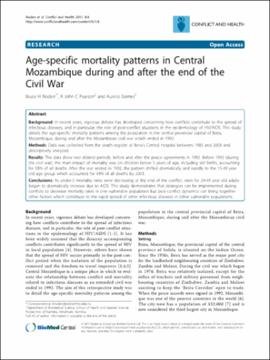| dc.contributor.author | Noden, Bruce H. | |
| dc.contributor.author | Pearson, R. John C. | |
| dc.contributor.author | Gomes, Aurelio | |
| dc.date.accessioned | 2022-04-12T13:55:19Z | |
| dc.date.available | 2022-04-12T13:55:19Z | |
| dc.date.issued | 2011-05-26 | |
| dc.identifier | oksd_noden_agespecificmortality_2011 | |
| dc.identifier.citation | Noden, B. H., Pearson, R. J. C., & Gomes, A. (2011). Age-specific mortality patterns in Central Mozambique during and after the end of the Civil War. Conflict and Health, 5(1), Article 8. https://doi.org/10.1186/1752-1505-5-8 | |
| dc.identifier.uri | https://hdl.handle.net/11244/335201 | |
| dc.description.abstract | Background: In recent years, vigorous debate has developed concerning how conflicts contribute to the spread of infectious diseases, and in particular, the role of post-conflict situations in the epidemiology of HIV/AIDS. This study details the age-specific mortality patterns among the population in the central provincial capital of Beira, Mozambique, during and after the Mozambican civil war which ended in 1992. | |
| dc.description.abstract | Methods: Data was collected from the death register at Beira's Central Hospital between 1985 and 2003 and descriptively analyzed. | |
| dc.description.abstract | Results: The data show two distinct periods: before and after the peace agreements in 1992. Before 1992 (during the civil war), the main impact of mortality was on children below 5 years of age, including still births, accounting for 58% of all deaths. After the war ended in 1992, the pattern shifted dramatically and rapidly to the 15-49 year old age group which accounted for 49% of all deaths by 2003. | |
| dc.description.abstract | Conclusions: As under-5 mortality rates were decreasing at the end of the conflict, rates for 24-49 year old adults began to dramatically increase due to AIDS. This study demonstrates that strategies can be implemented during conflicts to decrease mortality rates in one vulnerable population but post-conflict dynamics can bring together other factors which contribute to the rapid spread of other infectious diseases in other vulnerable populations. | |
| dc.format | application/pdf | |
| dc.language | en_US | |
| dc.publisher | Springer Science and Business Media LLC | |
| dc.relation.ispartof | Conflict and Health, 5 (1) | |
| dc.relation.uri | https://www.ncbi.nlm.nih.gov/pubmed/21615947 | |
| dc.rights | This material has been previously published. In the Oklahoma State University Library's institutional repository this version is made available through the open access principles and the terms of agreement/consent between the author(s) and the publisher. The permission policy on the use, reproduction or distribution of the material falls under fair use for educational, scholarship, and research purposes. Contact Digital Resources and Discovery Services at lib-dls@okstate.edu or 405-744-9161 for further information. | |
| dc.title | Age-specific mortality patterns in Central Mozambique during and after the end of the Civil War | |
| dc.date.updated | 2022-04-07T14:45:05Z | |
| osu.filename | oksd_noden_agespecificmortality_2011.pdf | |
| dc.description.peerreview | Peer reviewed | |
| dc.identifier.doi | 10.1186/1752-1505-5-8 | |
| dc.description.department | Entomology and Plant Pathology | |
| dc.type.genre | Article | |
| dc.type.material | Text | |
| dc.subject.keywords | HIV/AIDS | |
| dc.subject.keywords | Infectious Diseases | |
| dc.subject.keywords | 2.4 Surveillance and distribution | |
| dc.subject.keywords | Infection | |
| dc.subject.keywords | 16 Peace, Justice and Strong Institutions | |
| dc.subject.keywords | 3 Good Health and Well Being | |
| dc.subject.keywords | 1117 Public Health and Health Services | |
| dc.identifier.author | ORCID: 0000-0002-0096-370X (Noden, BH) | |
| dc.identifier.author | ScopusID: 6601968347 (Noden, BH) | |
| dc.identifier.author | ScopusID: 57197340886 (Pearson, RJC) | |
| dc.identifier.author | ScopusID: 15722351600 (Gomes, A) | |
